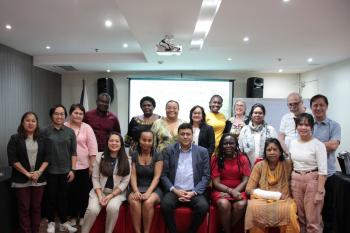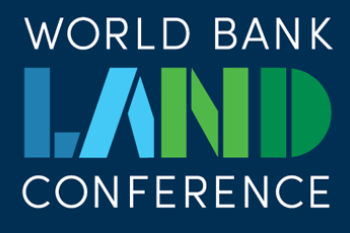
Ensuring Housing Rights through the Social Tenure Domain Model (STDM) in Post-conflict Marawi, Philippines
“There is nothing here now, everything has been flattened.”
This was the disheartened remark of Janodin Lao, 42, one of the thousands of internally displaced persons (IDPs) from Marawi City as a result of the five-month battle between ISIS-inspired militants and government forces in 2017. Three years after the siege, he returned home expecting to see posts and some walls standing as remnants of his house. But what welcomed him was flattened surface where not a single indication of his house remains -- only memories of life remembered and retold.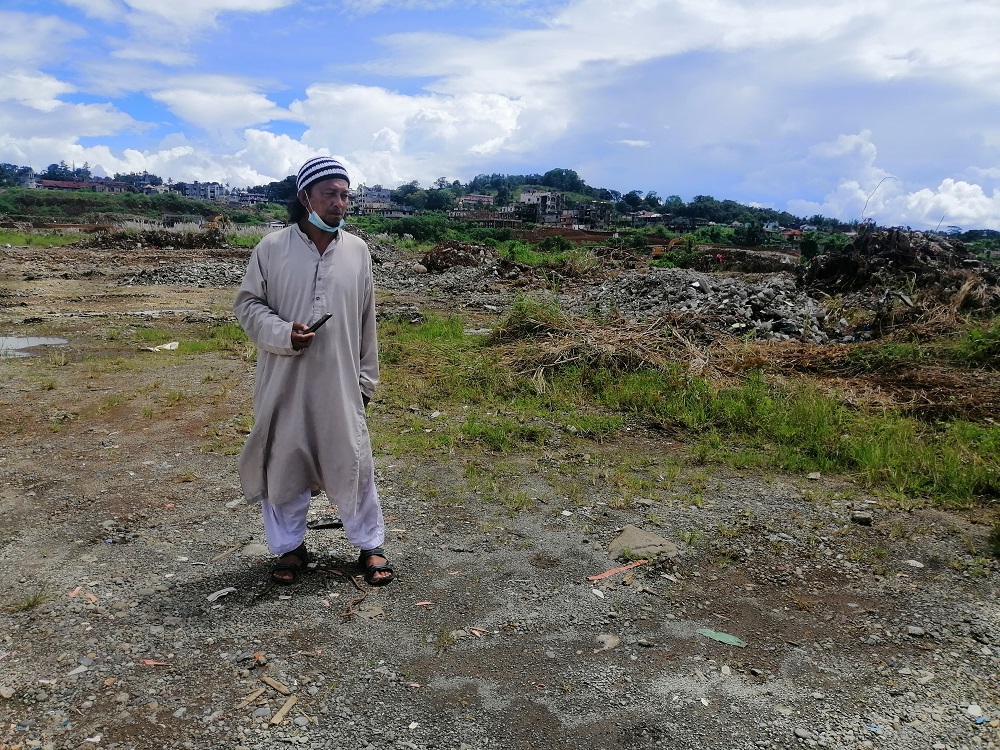 Janodin Lao standing on the spot where his house was located prior to the 2017 Marawi Siege
Janodin Lao standing on the spot where his house was located prior to the 2017 Marawi Siege
In post-war Marawi where lack of comprehensive land and property records pose as a continuing challenge, Janodin, as like other IDPs, hold on to the remaining debris as proofs of rights and ownership on housing, land, and property that they onced owned prior to the siege. He did not sign any demolition consent, so he was devastated when he came face-to-face with an empty lot which used to be his home. Janodin is one of the 1,500 home-partners of the Rebuilding Marawi through Community-driven Shelter and Livelihood Project being implemented by UN-Habitat Philippines in Marawi City, province of Lanao del Sur. Funded by the People of Japan, the project supports recovery efforts aimed at empowering IDPs to become proactive champions in rebuilding homes, livelihood, and peace in the communities. Active participation is ensured in every step of the project implementation through the People’s Process approach. The 1,500 home-partners organized into 31 Homeowners Associations (HOAs) and 33 Cooperatives working together towards the construction of shelters, engagement in various livelihood activities, building their capacities for community development, and promoting peace-building and environment and social safeguards. Participatory Process in STDM Adoption
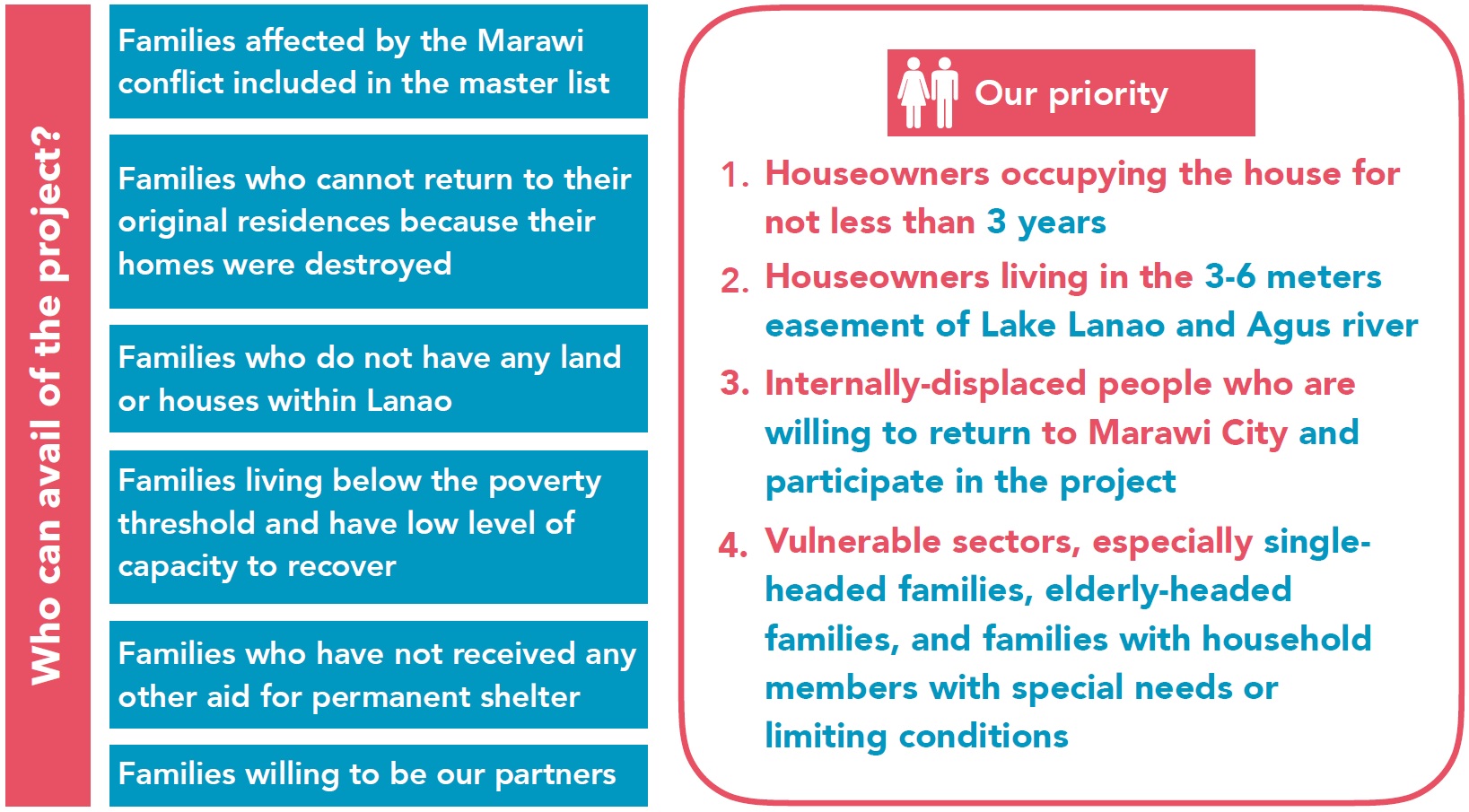 Criteria in the Project
Criteria in the Project
Community Baselining, Beneficiary Selection and Validation. Establishing the people-to-land relationship in post-conflict Marawi, particularly within the Most Affected Area (MAA)/Ground Zero where most structure lay in ruins, was a formidable challenge to the project. This is especially important since two of the beneficiary selection criteria requires linking houseowners with their physical house and its location. These two criteria are, 1) houseowners occupying the house for not less than three years, and 2) homeowners living within the 3-6 meters easement of Lake Lanao and Agus River – legally considered as no-dwell zone and high risk areas thus automatically barring IDPs from returning to their original location. The project referred to the master list of IDPs provided by the City Government through the Department of Social Welfare and Development (DSWD). As part of its validation process and in order to validate claims of meeting the priority criteria in beneficiary selection, UN-Habitat conducted transect walks in ground zero with barangay (village) and city officials and the IDPs themselves who located their houses and marked the exact location in the map provided by the barangays.
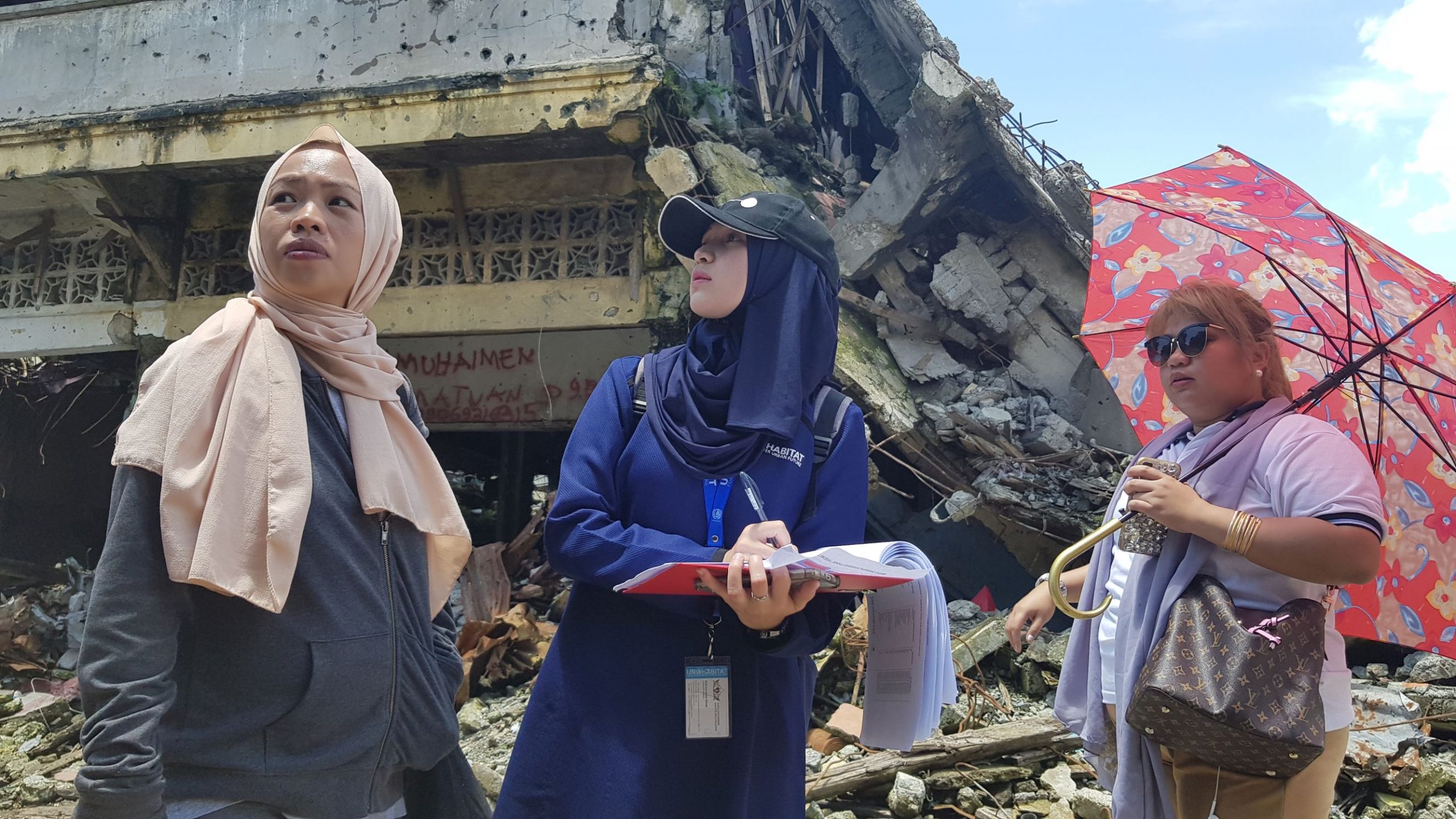 UN-Habitat staff with some IDPs during the transect walk at ground zero
UN-Habitat staff with some IDPs during the transect walk at ground zero
After the transect walk, shortlisted names were posted at strategic places at the Marawi City Hall for public viewing. Public feedback was encouraged within a specified period of time to confirm or challenge the names in the list and their qualification based on the criteria. The shortlisted names were also posted on the project’s social media page. As feedback came in, revalidation was conducted with barangay officials and key community leaders serving as key informants. Once this process was done, the final lists were posted. Project Orientation and Briefing Orientation on People’s Process and Project Briefing was conducted for those in the final lists. Families willing to participate in the Rebuilding Marawi Project signed a consent form while home-partners accomplished a Family Information Sheet (FIS) to document individual profile information about the home-partner and their families. The information was stored in the database. Mapping revalidation and database Link
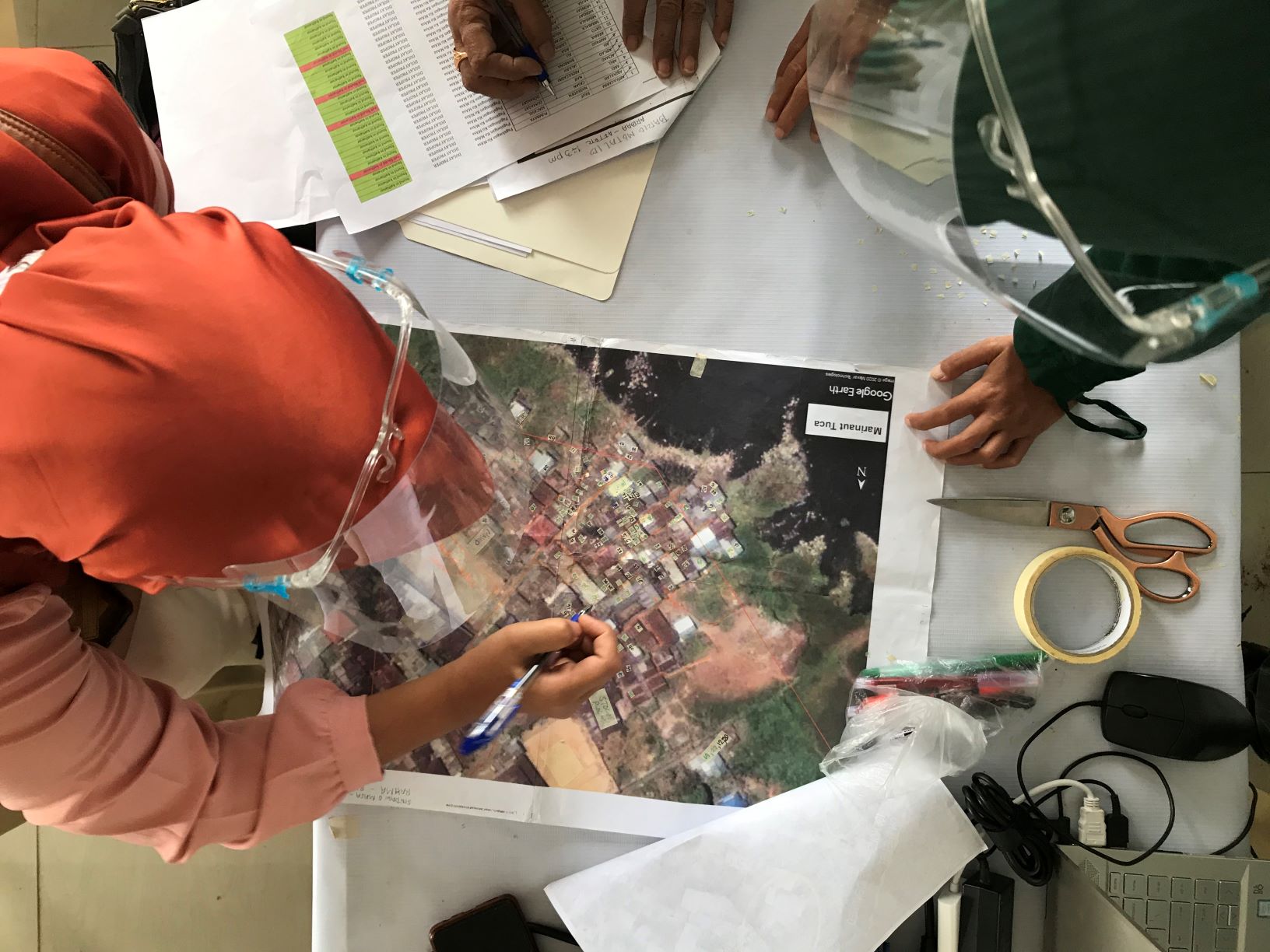 Home-partners marking the pre-siege location of their houses on printed Google Earth satellite image
Home-partners marking the pre-siege location of their houses on printed Google Earth satellite image
Further revalidation was conducted using printed Google Earth satellite images (from 2016, prior to the Marawi Siege) where the home-partners can identify the location and boundaries of their houses. Due to Covid-19 pandemic, where mobility restrictions are imposed, key officers of Homeowners’ Associations, and in some cases barangay captains, are invited to do the revalidation. This activity further helps UN-Habitat in the refining the project’s database by updating the information and linking their pre-siege location digitally in the database where their names and FIS data are stored. Challenges in Adopting STDM:
 Mapping revalidation and database updating amid Covid-19 pandemic
Mapping revalidation and database updating amid Covid-19 pandemic
1. Covid-19 pandemic mobility restrictions limits community engagement in mapping revalidation and database updating. Because of restrictions, home-partners cannot easily be physically present at the venue; 2. Some HOA officers who were assigned to assist in determining the exact location of the house of their HOA members were unfamiliar with the site, making the process time-consuming; and, 3. Hesitancy in marking other home-partners’ location on the map for fear of making an error and thereby earning their ire. Next Steps for STDM within the Rebuilding Marawi Project Implementation
- Once completed, the digital map with the database will be presented to project stakeholders, particularly the Task Force Bangon Marawi (TFBM). This represents the final list of home-partners who have been included in the priority list of the HOAs where they belong.
- The home-partners will be transferring to the shelter where their Homeowners’ Association are assigned. Each home-partner will be tagged to the location of their new house under the Rebuilding Marawi Project. This will be the initial recordation of land and housing rights in their new community.
- Formalization of the home-partners’ land rights (i.e. titling), either collective under their Homeowners’ Association (HOA) or individually, to ensure tenure security of the home-partners, depending on the agreement between the Rebuilding Marawi Project and its project partners, particularly those tasked in land procurement and site development: Social Housing Finance Corporation (SHFC), National Housing Authority (NHA), City Government of Marawi and Provincial Government of Lanao del Sur in coordination with Task Force Bangon Marawi. At this point, early coordination with land registration agency must be part of Estate Management and Sustainability Planning of the HOAs;
- The formalization of land rights is recommended to prevent the possibility of residential land dispute among and between neighboring home-partners as they settle down in their new houses. Conflict preventive measures that may include the placing of markers (“mohon”) delineating boundaries of individual land area is recommended for consideration by the HOAs;
- Mechanisms in updating the STDM in the future should be put in place by the HOAs as part of sustainability plan and as pro-active measure on people’s mobility, passing on of property titles as inheritance for surviving family members, etc. For this to be possible, capacity-building on updating the STDM that taps into the existing technology know-how among younger generation family members of home-partners can be included in discussions and plans. This same goes with the necessary hardware (computer) and software support for this to be realized;
- Training and turn over to local government (i.e. City Assessor and Building Official, etc.), barangay officials and pertinent national government agencies (e.g. Land Registration Agency, Register of Deeds, etc.). Sharing of the information to the City Social Welfare Office, the Ministry of Trade, Investment and Tourism, etc. can also be done to ensure provision of basic services the delivery of which, to be accurate and targeted, can make use of the comprehensive home-partners’ information made available through STDM;
- The documentation of collective ownership and use of public spaces and ensuring that women have equal access to these spaces and their safety assured, merit further discussion as part of establishing people-to-land relationships in the new communities;
- Estate management to be established to ensure operation and maintenance of community facilities, basic services and public spaces; and,
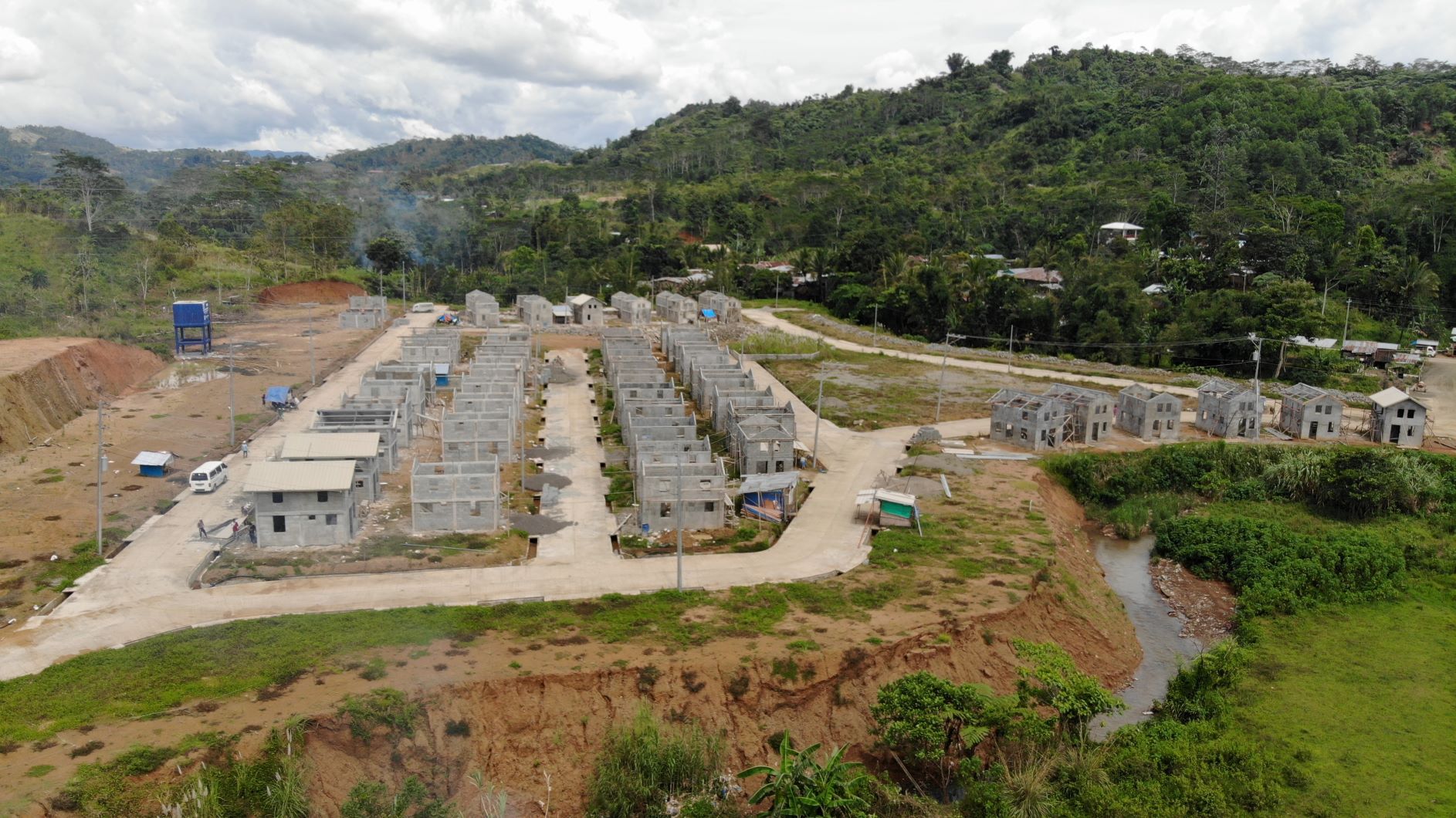 Shelter construction site, Brgy. Dulay West, Marawi City
Shelter construction site, Brgy. Dulay West, Marawi City
7. Land management within the new settlement areas, particularly in light of climate change and natural hazards, is to be considered – e.g. coordinating with the Ministry of Environment and Natural Resources for the prevention of soil erosion along creeks and elevated portions within and surrounding the subdivision.

